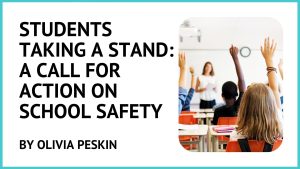By Stacey Steinbaum, Licensed Mental Health Professional, www.personaltherapyservices.com
As a mental health professional, I work with students every day who are navigating one of
the most intense and emotionally vulnerable times of their lives. They are not just learning
math and science, they’re trying to understand who they are, how they fit into their social
world, and how to manage an overwhelming amount of pressure coming at them from every
direction.
Today’s students are not only dealing with the usual growing pains of adolescence, they’re
doing so in a world that feels increasingly unsafe. With school shootings on the rise, many
students walk into their classrooms carrying not just backpacks and homework, but a quiet
undercurrent of anxiety: Will today be safe?
This fear is not abstract. It settles into the body, into the nervous system, into the way a
student shows up in class. It’s the silence in a normally chatty teen, the tearful outburst after
a small disappointment, the chronic stomachaches that have no medical cause. It’s the way a
student’s sense of safety, belonging, and mental health can quietly unravel under stress that
most adults couldn’t imagine facing in their own school years.
The Invisible Load Students Carry
On top of concerns about physical safety, students today are navigating a minefield of
emotional and psychological stressors that can significantly impact their mental health:
Social Media Pressure: Teens are bombarded with images of perfection. They compare
their everyday reality to highly curated, filtered snapshots of others’ lives and often feel they
fall short. Likes and comments can feel like a measure of worth. And cyberbullying, which
once stopped at the school gate, now follows them home in their pockets.
Academic Pressure: Students are under more pressure than ever to perform. High
expectations, standardized testing, competitive college admissions, and overloaded
schedules can turn school into a source of stress rather than growth. Even high-achieving
students often feel burned out, anxious, or chronically exhausted.
Peer Relationships: Friendships shift quickly, cliques form, and social status can change
overnight. Many students are also trying to understand themselves, who they are, who
they’re becoming, and how to fit in without losing themselves. This internal process can be
emotionally overwhelming, especially when layered with rejection, exclusion, or conflict.
Why Mental Health Support Belongs in Every School
Mental health isn’t a side issue; it’s a foundation. When students feel emotionally supported,
safe, and seen, they are far more likely to succeed academically, socially, and behaviorally.
But when mental health is ignored, students may struggle with:
- Chronic anxiety or depression
- Low motivation or disengagement from school
- Acting out or becoming withdrawn
- Difficulty focusing or completing work
- Self-harm or suicidal thoughts
Mental health support in schools isn’t just about having a counselor available. It’s about
creating a culture where students are taught how to regulate their emotions, ask for help,
build resilience, and communicate effectively. It’s about training teachers and staff to notice
warning signs early. And it’s about making school a place where students feel safe not just
physically, but emotionally.
Building a Culture of Care
As adults, we can’t control every stressor students face, but we can make sure they don’t
face them alone. Prioritizing mental health in schools is an investment in the emotional
future of a generation. Because when students feel mentally well, supported, and safe,
they don’t just survive school. They thrive in school.




















